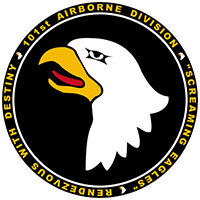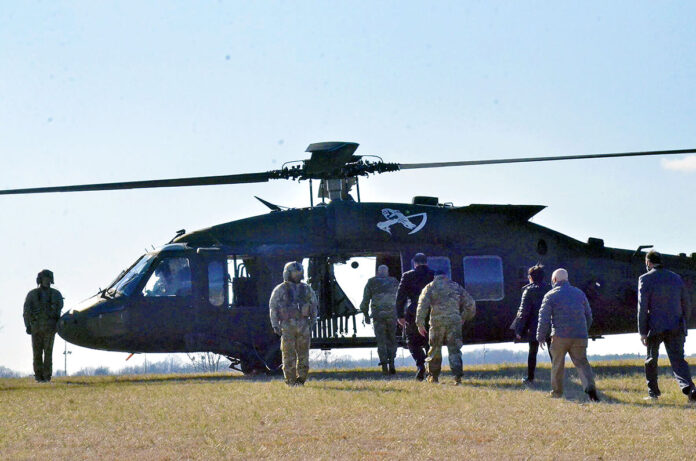 Fort Campbell, KY – Installation Services Director Michael E. Reheuser, Office of the Deputy Chief of Staff G-9, visited Fort Campbell February 6th-9th to gain perspective and assess conditions of housing, barracks, environmental programs, and municipal services.
Fort Campbell, KY – Installation Services Director Michael E. Reheuser, Office of the Deputy Chief of Staff G-9, visited Fort Campbell February 6th-9th to gain perspective and assess conditions of housing, barracks, environmental programs, and municipal services.
While on post, Reheuser took a close-up look at the installation’s housing options, water treatment plants, and the restored native grasslands in the Fort Campbell training areas.
“I’m here because of the support that we try to provide the installation in terms of funding and policy and guidance,” he said. “You learn a lot more by talking to people than you do sitting in the Pentagon, so really what I want to do [here] is have a dialogue.”
“The people I’ve met are dedicated professionals, both Army Civilians, and Soldiers, and the installation has a great culture to it,” he said. “It’s just a really integrated team in terms of what they do.”
Reheuser said he was especially impressed with how leaders across the installation bring their employees into the decision-making processes.
“Each of the organizations I met with solicits and values subordinate and employee input, and I think that’s a best practice,” he said. “The leadership sets out the basic goals and the direction that we’re moving in, but each of the leaders I met with encourages feedback from subordinates to better help understand the problem set and the possible solutions for the issues that we face.”
One example is the Integrated Natural Resources Management Plan, or INRMP, a long-term plan developed by gathering information from organizations across the installation.
“The budget’s getting tighter, we know that,” said Gene Zirkle, wildlife biologist, Conservation Branch, Fort Campbell Directorate of Public Works. “So that’s why building our partnerships internally at Fort Campbell is important, because what’s good for me is good for the rest of the folks. We have to pool our money, sit down and collaborate more to see where we want to go.”
That collective approach was responsible for the 1,352-acre Training Area 3 woodland and grassland restoration project, which leveraged Base Operations Support, or BOS, and Army Reimbursable Account, or ARA, funds to remove small trees and invasive species from the area over a two-year period. As a result, the garrison supported the training mission while also protecting at-risk species.
“I think that the way the environmental team addressed the grassland problem was really unique,” said Reheuser, who visited the area during his tour. “This collaborative effort allowed a great success, for the grasslands to be brought back and look the way they did many years ago while not adversely impacting the training ranges. To come to an installation and see the monies provided by the senior leaders being used to good effect was inspiring, frankly.”
Fort Campbell also invested a significant amount of money into on-post housing, and Reheuser said only Fort Hood, Texas, is working with more funding in that area.
The Army approved an $87.4 million development project in 2020 to support more than 140 new homes in the upcoming Erevia Park community, 170 major home renovations in New Hammond Heights, and the demolition of 250 outdated homes in LaPointe Village, among other community enhancements throughout the next five years.
Reheuser’s visit included a windshield tour of Erevia Park and a closer look at the ongoing renovations in New Hammond Heights, where he saw both the current floor plan and a renovated prototype.
“We’ve got 28 homes that we’ve completed to date, and we’re making pretty good progress,” said Karsten Haake, Lendlease project director for the Campbell Crossing community.
Renovations at each building are expected to last approximately six weeks, with overall completion expected in fall 2023.
“We are making very positive steps with our Family housing,” Reheuser said. “The [housing] partner here has received an influx of money that will be used to demolish old homes and build new ones, so that’s very positive. We are putting money into our barracks, but we have frankly a long way to go.”
According to Reheuser, the Army has approximately $2 billion in unfunded requirements related to barracks in its fiscal year 2022 budget, and the number of poor-quality barracks buildings across the enterprise has made barracks renovation a top priority for leadership.
Fort Campbell is home to several barracks that were built in the 1970s through Project Volunteer Army, or VOLAR, and Reheuser walked through one of them to better understand the living conditions.
“This is an area where we’re really hurting in the Army,” he said.
While Reheuser is working to help solve that issue in Washington, the Army’s next generation of civilian leaders is taking on problems of their own through this year’s Leadership Fort Campbell 2.0 cohort.
LFC 2.0 is a six-week professional development course that brings together employees from the Fort Campbell garrison to solve problems using Army Design Methodology, or ADM. Reheuser stopped by the Garrison Learning Center to learn about the program and take questions from participants.
“I was impressed with the complexity of the effort they’re undertaking,” he said. “I was impressed with the questions they asked about the Army as a whole, but also how they could improve themselves as individuals, and I was impressed that there were people from all different backgrounds and jobs on the installation working together to try to improve procedures.”
While LFC 2.0 students are tasked with solving a specific problem during their time in the course, the ultimate goal is for them to continue applying what they learned in their own directorates.
This is exciting because we are learning the ADM model in a real-time way, said Dr. Leigh Baldwin, psychologist and clinic chief, Fort Campbell Behavioral Health, Blanchfield Army Community Hospital.
“We’ll be able to take [what we learned] back to our respective environments and recreate this as ambassadors of the Army Design Methodology. We each have our own problem areas in our workspace, and we’re learning this so we can translate it into solving problems in each of our areas.”
Reheuser expects those efforts to go well since every employee he met during his tour was passionate about their work – one of many aspects of the installation that stood out to him, he said



